
|
You entered: evening sky
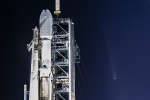 The Clipper and the Comet
The Clipper and the Comet
16.10.2024
NASA's Europa Clipper is now headed toward an ocean world beyond Earth. The large spacecraft is tucked into the payload fairing atop the Falcon Heavy rocket in this photo, taken at Kennedy Space Center the day before the mission's successful October 14 launch.
 Comet Hale-Bopp Over Val Parola Pass
Comet Hale-Bopp Over Val Parola Pass
16.03.1997
Comet Hale-Bopp is now much brighter than any surrounding stars. It can be seen even over bright city lights. Out away from city lights, however, it is putting on quite a spectacular show. Here Comet Hale-Bopp was photographed last week above Val Parola Pass in the Dolomite mountains surrounding Cortina d'Ampezzo, Italy.
 APOD: 2024 September 30 Б Comet Tsuchinshan ATLAS over Mexico
APOD: 2024 September 30 Б Comet Tsuchinshan ATLAS over Mexico
29.09.2024
The new comet has passed its closest to the Sun and is now moving closer to the Earth. C/2023 A3 (TsuchinshanБATLAS) is currently moving out from inside the orbit of Venus and on track to pass its nearest to the Earth in about two weeks.
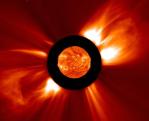 Double Trouble Solar Bubbles
Double Trouble Solar Bubbles
16.05.2002
During April and May, attention has been focused on the western evening sky, presenting its spectacle of bright planets and crescent moons shortly after sunset. Meanwhile, the Sun itself has not been just sinking quietly below the horizon.
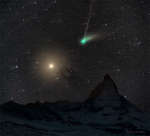 APOD: 2023 February 13 Б Comet ZTF and Mars
APOD: 2023 February 13 Б Comet ZTF and Mars
12.02.2023
No, Comet ZTF is not going to hit Mars. Nicknamed the Green Comet for its bright green coma, C/2022 E3 (ZTF) did, however, pass almost in front of the much-more distant planet a few days ago, very near in time to when the featured picture was taken.
 The SAR and the Milky Way
The SAR and the Milky Way
10.11.2023
This broad, luminous red arc was a surprising visitor to partly cloudy evening skies over northern France. Captured extending toward the zenith in a west-to-east mosaic of images from November 5, the faint atmospheric ribbon of light is an example of a Stable Auroral Red (SAR) arc.
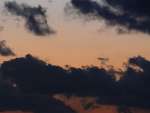 At first he couldn t see the Moon
At first he couldn t see the Moon
11.04.2008
At first, he couldn't see it, but searching with binoculars along a cloudy western horizon near sunset, photographer Laurent Laveder finally spotted a delicate lunar crescent. Captured in this dramatic picture on April 6th from Bretagne, France, the Moon was only 15 hours and 38 minutes old.
 The Tail of a Christmas Comet
The Tail of a Christmas Comet
24.12.2021
The tail of a comet streams across this three degree wide telescopic field of view captured under dark Namibian skies on December 21. In outburst only a few days ago and just reaching naked eye visibility Comet Leonard (C/2021 A1) is this year's brightest comet.
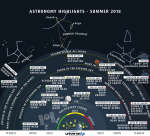 Highlights of the Summer Sky
Highlights of the Summer Sky
26.06.2018
What can you see in the night sky this summer? The featured graphic gives a few highlights for Earth's northern hemisphere. Viewed as a clock face centered at the bottom, early (northern) summer sky events fan out toward the left, while late summer events are projected toward the right.
 Comet Kudo-Fujikawa: Days in the Sun
Comet Kudo-Fujikawa: Days in the Sun
29.01.2003
Cruising through the inner Solar System, new Comet Kudo-Fujikawa reached perihelion, its closest approach to the Sun, yesterday, January 29. Passing within 28.4 million kilometers of the Sun, this comet came much closer than innermost planet Mercury basking only 57.9 million kilometers from our parent star.
|
January February March April |
|||||||||||||||||||||||||||||||||||||||||||||||||